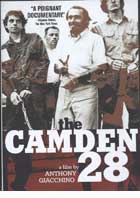
Camden 28 2006
Distributed by First Run/Icarus Films, 32 Court St., 21st Floor, Brooklyn, NY 11201; 800-876-1710
Produced by Anthony Giacchino
Directed by Anthony Giacchino
DVD, color, 83 min.
Sr. High - Adult
American Studies, Criminal Justice, History, Political Studies, Religious Studies
Date Entered: 12/12/2007
Reviewed by Jane Sloan, Rutgers University LibrariesIn 1971 a Camden, New Jersey, group of religious people—workers, social workers, teachers, former and active clerics, and a minister--determined to break into a local federal building and destroy all its military draft records. This slow developing, but powerful story about the nature of justice and peaceful protest is told through interviews with six members of the original group, who were arrested on the spot by the FBI. All 28 members endured a lengthy trial, only to be acquitted by a jury that chose to ignore their obvious guilt in favor of recognizing the critical part an FBI agent provocateur played in their successful breaking and entering. The jury was also influenced by the defense’s overall questioning of the Vietnam War effort, which was allowed by the judge.
While far from the only protest against Vietnam era military draft boards, the group was different in that they felt strongly about doing a thorough, rather than a symbolic, job so that more lives (of those who escaped the draft by their action) could be saved. But they did not know how to break into a building until they were joined by a 29th member, a painting contractor and active lay Catholic, who had all the tools and knowledge they lacked. This man, Bob Hardy, also appears in the film, where he is interviewed about his decision to become a mole for the FBI at the same time he continued to aid the group with their plans. In one of several turns in the story, he explains that the FBI promised him his friends would not go to jail, and, feeling betrayed by this deceit, he decided to testify in their defense.
The philosophy of the “Catholic left” of the time, and the historian Howard Zinn, who testified for the defense at the trial, bring context and depth to the argument that convinced the jury to acquit. Through this film, a student audience will learn in a most engaging way about the importance of civil disobedience in U.S. history, and about the political landscape of the 1970s -- the contradictions of military engagement and inner city poverty, and the depth of resistance to the war, including the committed political activists portrayed here. Zinn most clearly speaks of the difference between law and justice, while one of the Camden 28 says the trial was all about “Who went too far? Did the military go too far by entering Vietnam and continuing the war for 12 years or more? Did the Camden 28 go too far in trying to stop it?” In fact, the jury determined that the FBI went too far in promising their informant that his friends would not be jailed and providing him with all the necessary tools to assure their accomplishing their subversive act.
Much of the intelligence of the film comes from the film maker’s extraordinary research, which involved not only oral history, and the archival unearthing of all types of media, but convincing a New Jersey historical society to fund a recreation of the trial and reunion of the participants in 2002. Fascinatingly, the film maker convinced not only Bob Hardy, but members of the prosecution and the FBI to participate. The trial itself has a reputation as an important trial that established a precedent relating to government spying.